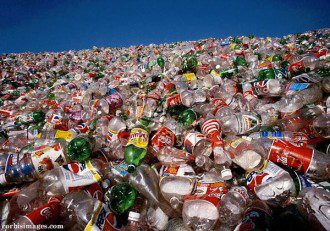Contributing Writer for Wake Up World
In a world addicted to plastic, it’s hard to imagine life without it. The problem is, plastic doesn’t breakdown safely and has proven itself to be exceedingly toxic for the planet and its inhabitants. We’re drowning in the stuff and it doesn’t look like our reliance on the material will end anytime in the near future. Radical solutions are needed — and soon.
A team of students has discovered what very well may be part of the answer: a plastic-eating fungus.
Choking to Death on a Modern ‘Wonder’ Material
Plastic is a relatively new material, developed in the last seventy years or so. As I wrote previously in “Plastic is Killing the Planet and Our Health — Here’s How We Can Turn the Tide,” the widespread use of the material is directly linked to the military needs of the United States:
[pro_ad_display_adzone id=”110028″]
“During World War II, raw materials were in short supply and we needed a resilient, economical and easily manufactured substitute. Plastic to the rescue! Made from readily available petroleum, plastic was the go-to material for the war machine. It was also a boon for oil companies as they had an entirely new market to tap — from 20 million pounds in 1927 to 650 million pounds by 1943. That’s a 3,000% increase in just a few short years.”
Jump to the present day. An article from The Huffington Post gives us a glimpse into how much plastic American consumers throw away each year, citing sobering data from the Environmental Protection Agency (EPA):
- Plastic Plates and Cups: 780,000 tons were produced, and all 780,000 tons were discarded.
- Plastic Bags, Sacks and Wraps: 3,960,000 tons were produced. 9.8% was recovered (390,000). 3,570,000 tons were discarded.
- Plastic Trash Bags: 930,000 tons were produced, and all 930,000 were discarded.
- “Other” non-durable goods including plastic disposable diapers, footwear and clothing: amounted to 4,810,000 tons produced with all 4,810,000 tons discarded.
- PET Bottles and Jars: 2,680,000 tons were produced, 27.2 % were recovered (730,000 tons) and 1,950,000 tons were discarded.
- HDPE (white translucent homopolymer bottles): 750,000 tons were produced, and 29.3 % (220,000 tons) were recovered. 530,000 tons were discarded.
- “Other Plastic Packaging” including coatings, closures, lids, caps, clamshells, egg cartons, produce baskets, trays, shapes, and loose fill: 3,720,000 tons were produced. 3% (110,000 tons) were recovered, and 3 Million 610 Thousand Tons were discarded.
Plastic isn’t really something we can sweep under the carpet and have it magically disappear without it causing problems, although we’ve certainly tried our best to do so — by dumping it into the ocean (so another country will have to deal with it), burying it in landfills (which eventually leach a toxic mess into the soil and ground water) or burning it (airborne DDT and PCBs anyone?).
The material is made to endure — which it does, for thousands of years. Every piece of it that was ever made is still with us today, most likely creating harm. Wildlife is strangled by it, toxic chemicals are released from it and humans suffer endocrine disorders because of harmful additives within it. Scientists can rant and rave about the dangers of plastic forever, but the reality is that most people aren’t willing to give up convenience and our single-use culture. What we need are creative, think-outside-the-box kind of solutions. As luck would have it, a group of students from Yale University have discovered a unique fungus which literally feasts on plastic.
A Healthy Appetite for Polyurethane
During an expedition to the Ecuadorian rainforest, students from Yale’s Department of Molecular Biophysics and Biochemistry screened several dozen fungi in an attempt to establish their ability to break down synthetic polymer polyester polyurethane (PUR). Published in the journal Applied Environmental Microbiology, the team found that “[s]everal organisms demonstrated the ability to efficiently degrade PUR in both solid and liquid suspensions. Particularly robust activity was observed among several isolates in the genus Pestalotiopsis, although it was not a universal feature of this genus.”
Apparently the mushroom can survive on polyurethane as its only food source. What’s more, it can live in a completely anaerobic (oxygen-free) environment, such as a landfill. The students believe the fungus is a promising approach to waste reduction, especially since it uses a natural, non-polluting processes to breakdown substances like plastic.
Additional Methods for Taming the Plastic Beast
Even though plastic-eating fungi are truly wonderful, they won’t completely solve our plastic troubles. What we need is a multifaceted approach. There’s always the old standby: Reduce. Reuse. Recycle. — which is a step in the right direction and certainly helps on a personal level. However, to really make a dent in our plastic load, we need to get industry on-board with biodegradable/recyclable packaging and products made from materials like hemp paper, cellulose, glass and metal. In all your interactions with manufacturers and retailers, urge them to embrace fully biodegradable packaging, eliminate single-use plastic bags and provide bulk purchasing options.
Another workable solution involves converting waste plastic into usable fuel (gasoline, kerosene and diesel). A Japanese company has created a plastic-to-oil conversion system, which can be used for both industrial and home applications. By utilizing this method, CO2 emissions are reduced by an impressive 80% compared to conventional burning of plastic. The creator stresses that if we were only to use fuel from plastic — instead of oilfields — we would drastically reduce our pollution and waste. You can read more about the process here.
There is one possibility that is glaringly absent from the recommended eco-friendly list: bioplastics. This is because biodegradable, plant-based plastics generally need to be disposed of at an industrial composting facility, which are few and far between. Some products are beginning to emerge that can be composted at home, but they aren’t mainstream yet. When dumped in a traditional landfill, bioplastics rarely breakdown in the anaerobic atmosphere. And when they do, they release methane gas — one of the worst emissions contributing to global warming. Moreover, bioplastic in the ocean takes months to breakdown, which is plenty of time to endanger wildlife. We also have to take into account the impact plastics made from renewable resources will have on arable land, fresh water supplies and soil erosion. Ethanol gas is one example of how a ‘green solution’ can compete with the food supply — in this case, corn.
Even though bioplastics are not a viable, long-term solution for our growing plastic crisis, there are plenty of other ways we can minimize our plastic waste footprint. Have a look at this article for practical ideas and inspiration.
Article sources
- http://www.thepetitionsite.com/128/344/384/stop-killing-the-environment-and-our-health-with-plastic
- http://aem.asm.org/content/77/17/6076
- http://www.huffingtonpost.com/lisa-kaas-boyle/the-facts-about-plastic-p_b_800013.html
- http://themindunleashed.org/2014/08/fungus-discovered-rainforest-capable-eating-plastic-pollution.html
- http://www.herbcyclopedia.com/item/amazonian-mushroom-eats-plastic-pestalotiopsis-microspora-2
- http://www.epa.gov/wastes/nonhaz/municipal/pubs/msw2008data.pdf
- http://www.algalita.org/bioplastics-are-they-the-solution
- https://wakeup-world.com/2015/05/04/plastic-is-killing-the-planet-and-our-health-heres-how-we-can-turn-the-tide
- http://news.stanford.edu/pr/2009/pr-biocomp-031809.html
- https://wakeup-world.com/2015/06/08/dont-trash-that-plastic-bottle-convert-it-into-fuel-instead
Recommended articles by Carolanne Wright:
- Dr Sebi: The Man Who Cures Aids, Cancer, Diabetes and More
- Chronic Lyme Disease: A Modern Plague the Government Chooses to Ignore
- Big Pharma and Organized Crime — They are More Similar Than You May Think
- Over 100 Scientific Studies Agree: Cannabis Annihilates Cancer
- Emotional Energetic Healing: The Future of Medicine is Here
- Why Every Parent Should Consider Unschooling
- The Greenhouse of the Future: Grow Your Own Food Year-Round With This Revolutionary System
- First U.S. City Produces More Electricity Than It Uses — With 100% Renewable Technology
- Autistic Boy with Higher IQ Than Einstein Discovers Gift After Removal from State-Run Therapy
- Enhance Spiritual, Mental and Physical Well-being with a Pineal Gland Detox
[pro_ad_display_adzone id=”110025″]
[pro_ad_display_adzone id=”110027″]







